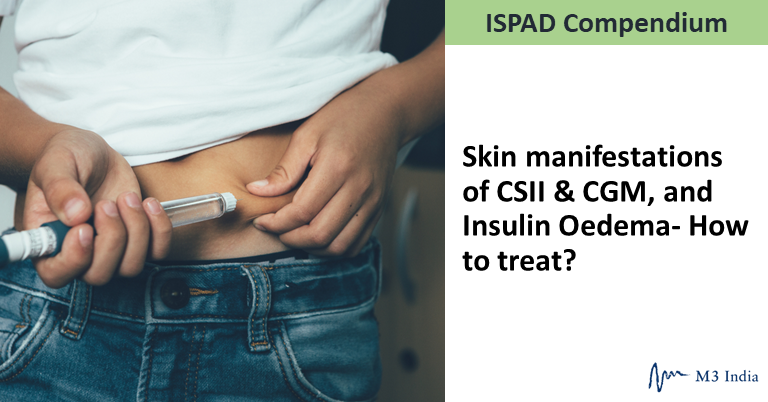'Skin manifestations of CSII & CGM, and Insulin Oedema- How to treat?': ISPAD Compendium
M3 India Newsdesk Jul 02, 2019
Long-term use of insulin pumps or aggressive insulin therapy in paediatric T1D patients can lead to dermatological issues such as infections, abscesses, contact dermatitis, lesions, and insulin oedema. This article covers practice pointers from ISPAD 2018 compendium on how best to treat these skin conditions.

Type 1 Diabetes (T1D) in children and adolescents brings along quite a few skin conditions. This as mentioned in the ISPAD Clinical Practice Consensus Guidelines 2018 Compendium lists the common dermatological conditions linked to T1D and the prolonged use of insulin in patients.
Important recommendations include:
- Spreading awareness about the risk of skin irritation due to the use of insulin pumps and continuous glucose monitoring (CGM). Also recommending rotation of pump and sensor insertion sites; clinicians should be well aware of this information to share with patients.
- Screening for vitamin D deficiency, especially in young patients and high-risk T1D groups, such as patients demonstrating celiac disease or darker skin pigmentation, and recommending treatment as per appropriate guidelines.
Given below are the various skin conditions associated to T1D and the recommendations for the diagnosis, treatment and management of the same:
Skin Manifestations of Continuous Subcutaneous Insulin Infusion (CSII) and Continuous Glucose Monitoring (CGM)
Combined use of CSII and CGM involves injecting at multiple sites, which add to the risk of skin-related complications. This especially holds good for long-term pump users and younger T1D patients, who have a smaller surface area available for sites.
Poor sterile technique employed for the insertion of insulin infusion sets and prolonged use of CSII are linked to microbial colonisation. This may result in infections and abscesses, commonly caused by Staphylococcus aureus and Staphylococcus epidermidis.
Use of CGM may also be related to problems like skin irritation. Patients may also find it difficult to keep the sensor or transmitter attached, which may limit successful CGM use in some patients. Skin irritation may get worse due to high temperatures and humidity, excessive sweating and contact dermatitis and skin irritation arising due to CGM adhesive, other adhesive products, plastic or nickel parts of the sensor, support mount, and/or transmitter.
Treatment options
- Skin infections can be prevented by changing the infusion set catheter regularly or at least every 3 days, using a sterile technique and ensuring good hygiene.
- To prevent rashes and dry skin, which may happen due to the frequent application and removal of the sensor adhesive or additional adhesive products, patients should be taught how to rotate the sensor insertion sites. Also, to make sensor removal less traumatic for patients, adhesive removers could be used to prevent rashes and dry skin, especially in overused areas.
- Using supplementary products to minimise these issues can help reduce skin irritation and improve adherence.
- Transparent dressings and film barrier products can be used when the patient is suspected to have an allergic reaction to the adhesive or skin irritation due to the plastic or metal components of the sensor/transmitter unit.
- Eczematous lesions should be treated as per standard guidelines, which includes the use of emollients and topical steroid creams, as required.
Insulin Oedema
Insulin oedema, a rare complication, can develop due to insulin therapy. It normally occurs shortly after the beginning of intensive insulin therapy in newly diagnosed and poorly controlled patients and even those T1D patients, who follow a high-dose insulin therapy but are malnourished.
Although there are no statistics available for insulin oedema rate, it is commonly reported among children and adolescents. As per the ISPAD Compendium, the cause is believed to be increased capillary permeability caused by chronic hyperglycemia as well as the direct effect of insulin, which can have a straight anti-natriuretic effect on the kidney. The ISPAD Guideline also states that (as per the study that was conducted) insulin was the reason behind the increase in vascular permeability in both, healthy individuals and T1D patients.
Treatment options
- Short-term diuretic treatment, salt restriction and ephedrine are said to be effective in the treatment of acute oedema
- Decreased insulin doses can also help in reducing oedema
Insulin oedema mostly improves spontaneously in 1 to 3 weeks
Other diabetes-related skin conditions
Hyperglycaemia leads to important metabolic and immunological alterations, hence diabetes patients are more prone to skin infections. Other skin conditions that can be linked to diabetes include, granuloma annulare, diabetic dermopathy, acquired perforating dermatosis and bullosis diabeticorum or diabetic bulla. Besides these, there are some skin disorders that occur more frequently in diabetic patients, such as pruritus, xerosis, lichen planus, finger pebbles and skin tags.
-
Exclusive Write-ups & Webinars by KOLs
-
Daily Quiz by specialty
-
Paid Market Research Surveys
-
Case discussions, News & Journals' summaries